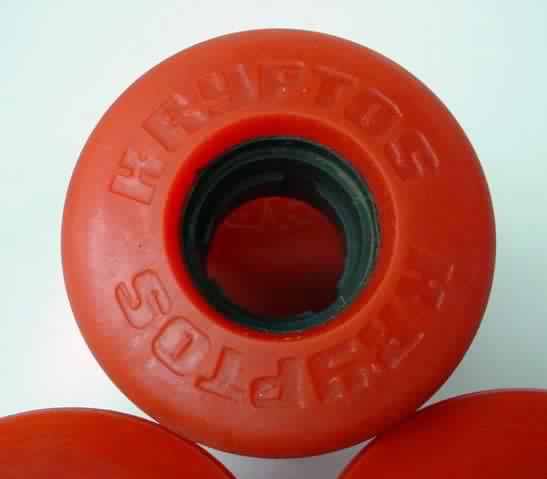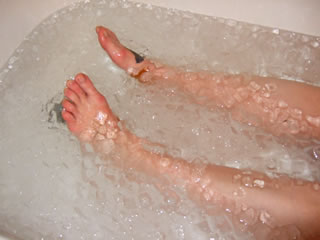
A teacher's greatest dilemma is whether to teach gates or stone bridges.
Getting around a traditional Chinese city, village or home is all about going through gates. Thus
"going through a gate" is a primary metaphor used to describe learning something or getting something done. It is also a primary metaphor for describing movement of qi around the body. For instance, the shoulder and the hip each have a major gate that allows qi to move between the limbs and the torso.
I did a lot of skateboarding in my teens. Every day I skated steep hills with (by todays standards) large
70 millimeter Kriptonics wheels. I'm what the kids today call O.G. (Old Gangster). There are very few people with this particular experience around. Downhill skiers and snowboarders have some comparable skills, so I

can at least communicate with them, but snow is softer than concrete and there aren't a lot of cars on the slopes.
Skateboarding was a gate I passed through to get to my current understanding of internal martial arts. It still informs my practice. When I heard the taijiquan saying "You must go left in order to go right" I understood it immediately, skateboarding works the same way. If you are going to make a high speed 90 degree turn into traffic you have to feel your pathway through space and along the ground before you make the actual
sequence of turns that will get you into the little space between the the moving cars and the parked cars. Just turning to the right will get you squished.

Now when I teach, I'll say something like "Do this," or "Copy me," but nine times out of ten the student doesn't quite do what I'm hoping they will do. So I'll describe what I'm doing, or let the student feel my torso moving. But often they still don't "get it." I think, o.k., if I was in their body I would just do "this" and "this" and "that other thing." From where I'm standing I can see exactly what they need to do to get to where I am.
It is as if there were a stone bridge that, if they could see it, they could just walk across.But they don't see the bridge. So I have a choice. I can either keep trying to get them to see the bridge, or I can take them through some of the gates I passed through on my way to achieving my current skill level.
I do have some memory of the hundreds of gates I passed through to get to my current skill level in internal martial arts. From a teacher's point of view, the only proven method for getting to where I am, is to pass through all the same gates I passed through. However, it isn't

realistic for me to ask all my taijiquan students to take up downhill skateboarding.
What most teachers do at this point is to make up a list of gates (exercises, experiences) that will hopefully be a shorter route to excellence than the one the teacher took to get there. Some of the gates I teach are ones I passed through myself, some are gates that I think are improvements on the ones I passed through, and some are gates I put there because I'm hoping that the student might notice the stone bridge off to their left on the way through.
Every teacher, whether he is rigid, traditional, experimental, or inspired, has to decide whether to point to the stone bridge, or guide students through gates. I wish I understood this when I first started studying gongfu.



 Wow, it was fun putting those three names together.
Wow, it was fun putting those three names together. Wilhelm Reich
Wilhelm Reich Reich is also extraordinary because he was probably the first to say that Nazi's and Communists are the same. His reason was also way ahead of his time: They both used the same repressive physicality to perpetuate fear of self-awareness; a fear which makes people want to be told what to do.
Reich is also extraordinary because he was probably the first to say that Nazi's and Communists are the same. His reason was also way ahead of his time: They both used the same repressive physicality to perpetuate fear of self-awareness; a fear which makes people want to be told what to do. Katherine Dunham
Katherine Dunham  Yesterday, having just gotten into my warm car after watching the latest Stephen King movie and nearly freezing to death talking to a fellow movie goer in the wind, I saw a small group of high school girls crossing the street. Very sort pants, low socks, t-shirts. One of them had big lumps of plastic wrap around her knees and ankles. I suddenly registered that they were athletes and that the plastic wrap was holding large amounts of ice on the unfortunate young womans legs.
Yesterday, having just gotten into my warm car after watching the latest Stephen King movie and nearly freezing to death talking to a fellow movie goer in the wind, I saw a small group of high school girls crossing the street. Very sort pants, low socks, t-shirts. One of them had big lumps of plastic wrap around her knees and ankles. I suddenly registered that they were athletes and that the plastic wrap was holding large amounts of ice on the unfortunate young womans legs. Th
Th ere are a whole bunch of theories about why ice is good, but my experience tells me that mostly it is terrible. It is better than nothing on burns, but if you have burn cream, it is better. There is no question that ice can bring down swelling after an injury. For a really bad injury I would put ice on it right away. But as part of a training ritual, it is barbaric. It develops bad, tense, stiff, muscle quality and in the long run it probably leads to arthritis.
ere are a whole bunch of theories about why ice is good, but my experience tells me that mostly it is terrible. It is better than nothing on burns, but if you have burn cream, it is better. There is no question that ice can bring down swelling after an injury. For a really bad injury I would put ice on it right away. But as part of a training ritual, it is barbaric. It develops bad, tense, stiff, muscle quality and in the long run it probably leads to arthritis. When I was young and road my bicycle at high speed over steep hills to all my appointments, swam in the freezing cold ocean, did kungfu and dance for 6 or even 8 hours every day, and sat still (or slept) in stupid classes at school--a nice hot bath once or twice a week was very close to Nirvana. Still, as a training method it contributed nothing. I was tired and stiff because I was training too much of the wrong thing. It would be better just to train right. Too much hot drains the qi.
When I was young and road my bicycle at high speed over steep hills to all my appointments, swam in the freezing cold ocean, did kungfu and dance for 6 or even 8 hours every day, and sat still (or slept) in stupid classes at school--a nice hot bath once or twice a week was very close to Nirvana. Still, as a training method it contributed nothing. I was tired and stiff because I was training too much of the wrong thing. It would be better just to train right. Too much hot drains the qi. change some of your clothes.
change some of your clothes. I've been looking for information on Daoist ritual shoes. I was sure that somewhere I'd seen special Daoist ritual shoes which are 3 inch high stilts. These shoes make it impossible to put weight on the toes or the heel since the stilt post goes down from the center of the foot. Since the base the the stilt is thicker at the bottom, kind of like a mushroom, there is a plenty of space to balance. The problem is I have been unable to find these shoes (so no picture). Did I dream them? How embarrassing.
I've been looking for information on Daoist ritual shoes. I was sure that somewhere I'd seen special Daoist ritual shoes which are 3 inch high stilts. These shoes make it impossible to put weight on the toes or the heel since the stilt post goes down from the center of the foot. Since the base the the stilt is thicker at the bottom, kind of like a mushroom, there is a plenty of space to balance. The problem is I have been unable to find these shoes (so no picture). Did I dream them? How embarrassing. Dream or not, these shoes represent ultimate shamanic power. The symbolic steps Daoists take in ritual cover huge distances. They circumambulate the empire, the world, and they traverse the distances between stars in the sky.
Dream or not, these shoes represent ultimate shamanic power. The symbolic steps Daoists take in ritual cover huge distances. They circumambulate the empire, the world, and they traverse the distances between stars in the sky.
 kidney system. The kidneys regulate fluids in the body and they also produce jing. Jing is that aspect of qi which comprises the self reproductive quality in nature, it is stored in the kidney system where it is available both for making babies and for making repairs. Jing produces new tissue when we are injured, bone, muscle, scabs, etc. It is our ancestral memory.
kidney system. The kidneys regulate fluids in the body and they also produce jing. Jing is that aspect of qi which comprises the self reproductive quality in nature, it is stored in the kidney system where it is available both for making babies and for making repairs. Jing produces new tissue when we are injured, bone, muscle, scabs, etc. It is our ancestral memory. I don't think there is a perfect correlation between physical rigidity and a person's inability to freely make choices based entirely on what is real. There is some correlation, but I've met some amazing people with pretty screwed up bodies. Still, sit-ups are dumb. Six-pack abdominal muscles are O.K. against a boxer with gloves on and that's it. Like the "core-strength" fad, sit-ups break the unity of a person's body, they restrict the freedom of the torso and they tighten the breath. Why choose a rigid fate?
I don't think there is a perfect correlation between physical rigidity and a person's inability to freely make choices based entirely on what is real. There is some correlation, but I've met some amazing people with pretty screwed up bodies. Still, sit-ups are dumb. Six-pack abdominal muscles are O.K. against a boxer with gloves on and that's it. Like the "core-strength" fad, sit-ups break the unity of a person's body, they restrict the freedom of the torso and they tighten the breath. Why choose a rigid fate? A person standing on two feet is an unstable structure.
A person standing on two feet is an unstable structure. The concept of Shen has so many meanings in Chinese that it probably deserves a whole book. The shen I'm talking about here is the one that is most often translated "spirit" and is the lighter more expansive aspect of qi. (I'm not going to attempt a comprehensive definition.)
The concept of Shen has so many meanings in Chinese that it probably deserves a whole book. The shen I'm talking about here is the one that is most often translated "spirit" and is the lighter more expansive aspect of qi. (I'm not going to attempt a comprehensive definition.) I believe that hormones have a big effect on shen. How many of us have known a slender woman who once a month asks if we think she is fat? The first time this happens we laugh and say, "Yeah your a regular hippo." The second time this happens we say, "No, honey, of course not," only to be accused of being patronizing or worse. No doubt most of us have learned, through trial and error, that a failure to respond will be received as "ignoring," and that the best response is an audible but non-verbal response:
I believe that hormones have a big effect on shen. How many of us have known a slender woman who once a month asks if we think she is fat? The first time this happens we laugh and say, "Yeah your a regular hippo." The second time this happens we say, "No, honey, of course not," only to be accused of being patronizing or worse. No doubt most of us have learned, through trial and error, that a failure to respond will be received as "ignoring," and that the best response is an audible but non-verbal response: Martial Development
Martial Development
 move just one part. Each vertebral-body (bone) can tilt forward or backwards somewhat like Venetian blinds.
move just one part. Each vertebral-body (bone) can tilt forward or backwards somewhat like Venetian blinds. Figure 10. A sagittal view of the human thoracic spinal cord, showing the (1) intervertebral discs, (2) vertebral bodies, (3) dura, (4) epidural space, (5) spinal cord, and (6) subdural space. A thick ligament, the anterior longitudinal ligament forms the anterior border of the spinal column. The posterior longitudinal ligament form the posterior border of the vertebral bodies.
Figure 10. A sagittal view of the human thoracic spinal cord, showing the (1) intervertebral discs, (2) vertebral bodies, (3) dura, (4) epidural space, (5) spinal cord, and (6) subdural space. A thick ligament, the anterior longitudinal ligament forms the anterior border of the spinal column. The posterior longitudinal ligament form the posterior border of the vertebral bodies. A teacher's greatest dilemma is whether to teach gates or stone bridges.
A teacher's greatest dilemma is whether to teach gates or stone bridges. can at least communicate with them, but snow is softer than concrete and there aren't a lot of cars on the slopes.
can at least communicate with them, but snow is softer than concrete and there aren't a lot of cars on the slopes.
 realistic for me to ask all my taijiquan students to take up downhill skateboarding.
realistic for me to ask all my taijiquan students to take up downhill skateboarding.